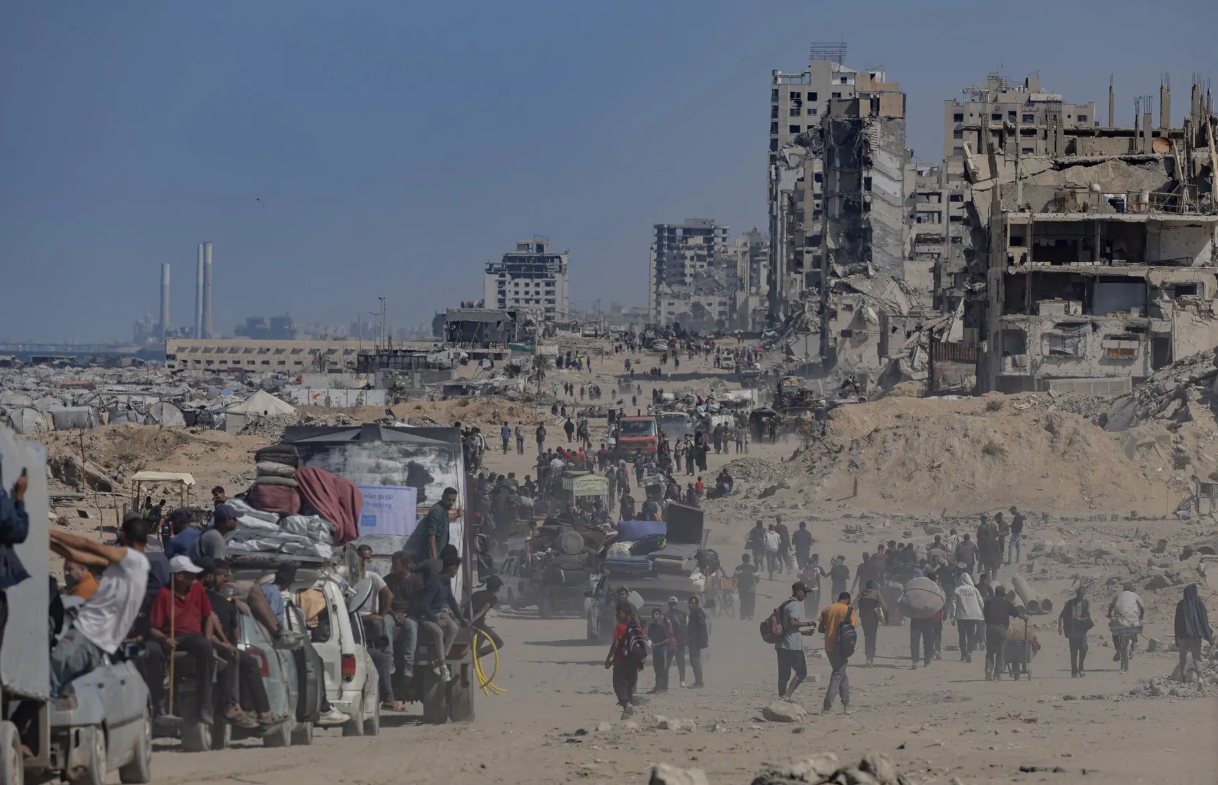Sure! Here’s a rephrased version that keeps the meaning intact but changes the wording a bit:
The cease-fire in Gaza has taken effect, and hostages and prisoners have been exchanged. Yet, after two years of devastating conflict, a deep sense of gloom remains.
On Monday, Palestinians in Gaza expressed relief that Israel had ended its two-year military offensive and that prisoners had been swapped. However, many felt there was little cause for celebration.
Two years of war have left Gaza in ruins—cities reduced to rubble, tens of thousands dead, and the healthcare system shattered. Despair and hopelessness are widespread, with many struggling to envision a future.
“It’s important that the bombing has stopped, but there’s nothing to celebrate,” said Saed Abu Aita, 44, who is displaced in central Gaza. “My two daughters were killed, my home destroyed, and my health has worsened.”
According to local health officials, Israel’s military campaign against Hamas killed over 67,000 people in Gaza. The figures do not distinguish combatants, but thousands of those killed were children.
Some Palestinians in Gaza say the release of nearly 2,000 Palestinian prisoners on Monday—a key reason Hamas cited for starting the war—is not worth the immense cost.
Hamas secured the exchange by releasing the remaining hostages from the roughly 250 seized during the October 7, 2023 attack on southern Israel that triggered the war.
Mr. Abu Aita recalled being wounded when shrapnel pierced his rib cage during an Israeli airstrike in his hometown of Jabaliya in northern Gaza in October 2023. He has been unable to find a doctor able to remove the fragment for over a year.
He hopes the return of the last 20 living hostages to Israel on Monday—a crucial part of the cease-fire that began last week—will lead to the end of the conflict.
“They should have gone home a long time ago,” he said. “Holding them in Gaza gave Israel a pretext to continue bombing.”

Palestinians in Gaza have endured hunger, fear, and relentless bombardment. With the cease-fire now in place, aid organizations say they are working to ramp up relief efforts as much as possible to ease the humanitarian crisis and help people begin rebuilding their lives.
Many aid workers blame Israeli restrictions for shortages that caused widespread hunger and malnutrition across Gaza. While Israel blocked all supplies from entering Gaza for nearly three months earlier in 2025, Israeli officials have recently said they are no longer limiting aid shipments into the territory.
Under the cease-fire deal, Israel has pledged to allow a significant increase in urgently needed supplies into Gaza.
On Sunday, the United Nations announced efforts to boost aid deliveries to Gaza, including bringing cooking gas for the first time since March. Many residents have had to bake bread using firewood due to the scarcity of gas and electricity.
“For two years, we have dreamed of this moment,” said Amani Nasir, 30. “We’ve endured enough tents, fires, displacement, and thirst.”

The agreement calls for at least 600 trucks of supplies to enter Gaza daily, and Gaza’s Rafah border crossing with Egypt will be reopened.
Abdel Nasser al-Ajrami, head of Gaza’s Bakers’ Union, which works with the World Food Program to distribute subsidized bread, said conditions have steadily improved since the cease-fire was announced last week.
“Today is better than yesterday, and hopefully tomorrow will be better,” he said, noting that 17 bakeries are now operating across central and southern Gaza.
However, skepticism remains about whether the cease-fire will hold.
The agreement brokered last week by U.S., Qatari, Turkish, and Egyptian mediators did not resolve some of the most difficult issues between the parties. Hamas remains armed and continues to control parts of Gaza for now.
Israeli Prime Minister Benjamin Netanyahu has said his government will not agree to end the war until Hamas’s government and military wing in Gaza are dismantled.
While Hamas has expressed willingness to hand over civilian governance to another Palestinian body, it has not committed to disarming.
Since Israel paused its military offensive and withdrew from parts of Gaza in recent days, Hamas has started reasserting control on the streets.
Eyewitnesses reported seeing small groups of Hamas internal security fighters guarding some intersections.
On Sunday night, Hamas fighters clashed in Gaza City with a rival gang, attempting to capture its members, according to the Hamas-run Interior Ministry.
During a visit to Israel on Monday coinciding with the hostage release, former President Trump was asked about Hamas reasserting itself as a policing force and confronting rivals.
He responded that Hamas “wants to stop the problems” and suggested the U.S. was temporarily not opposed to this.
“They’ve been open about it, and we gave them approval for a period of time,” Trump said.
Trump envisions a postwar security force to stabilize Gaza and training a new Palestinian police force to maintain order, but this will be difficult if Hamas insists on remaining dominant.
Abdullah Shehab, 32, worries the cease-fire may be short-lived because Hamas has not agreed to Israel’s conditions for ending the war.
In recent days, he said, Hamas has been showing it “hasn’t given up its rule” over Gaza.
On Sunday, masked gunmen believed to be Hamas members stopped him on his way to the dentist and searched his car.
“The situation is very fragile,” he said. “The weaker party, Hamas, has not yet been convinced to accept the stronger party’s demands.”
